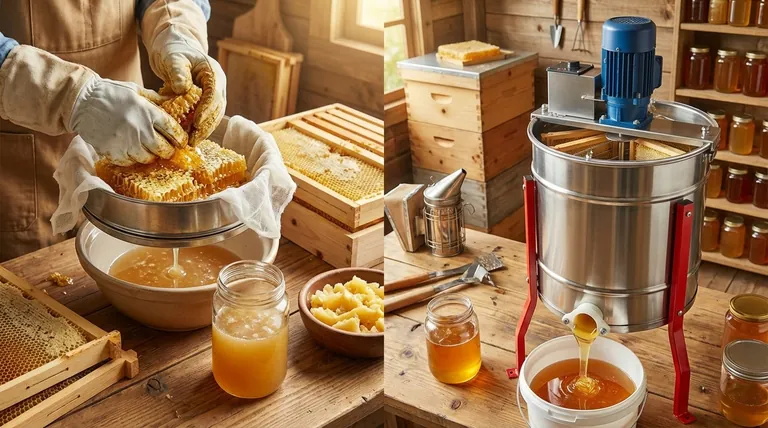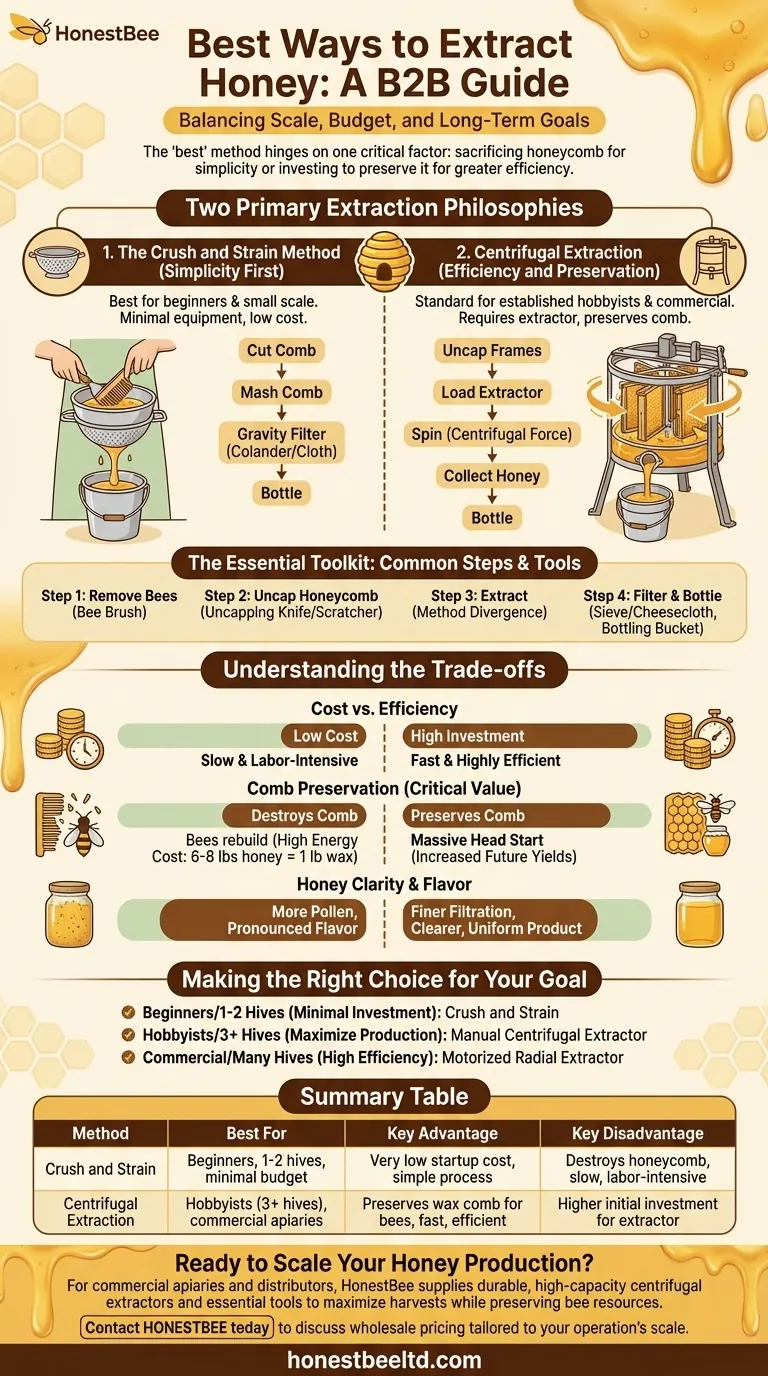For the small-scale or first-time beekeeper, the best method is Crush and Strain, which involves mashing the honeycomb and filtering the honey through a simple colander and cloth. For beekeepers with several hives who plan to continue the hobby, the best method is Centrifugal Extraction, which uses a machine to spin honey out of the frames, preserving the delicate wax comb for the bees to reuse.
The "best" way to extract honey is not a single method, but a choice that balances your scale, budget, and long-term goals. The decision hinges on one critical factor: whether you want to sacrifice the honeycomb for simplicity or invest in equipment to preserve it for greater efficiency.

Two Primary Extraction Philosophies
Your approach to honey extraction will fall into one of two main categories. One prioritizes low cost and simplicity, while the other prioritizes efficiency and the preservation of bee resources.
The Crush and Strain Method (Simplicity First)
This is the most accessible method for beginners. It requires minimal specialized equipment.
The process involves cutting the honeycomb out of the frame, crushing it to break open all the wax cells, and placing the resulting mash into a filter.
Commonly, a colander lined with cheesecloth or a dedicated honey filter is set over a food-grade bucket. Gravity does most of the work, with the honey slowly draining out over several hours.
Centrifugal Extraction (Efficiency and Preservation)
This method is the standard for established hobbyists and commercial beekeepers. It requires a machine called a honey extractor.
An extractor is a drum with a mechanism that holds the frames and spins them at high speed. Centrifugal force flings the honey out of the cells and onto the drum wall, where it runs down to a collection gate at the bottom.
The single greatest advantage of this method is that it leaves the drawn wax comb almost entirely intact, allowing you to return the empty frames to the hive.
The Essential Toolkit: A Step-by-Step Breakdown
Regardless of your chosen method, the initial steps and tools for preparing the frames are largely the same.
Step 1: Removing Bees from the Frames
Before bringing your honey frames indoors, you must clear them of bees. A soft bee brush is the simplest tool for gently sweeping bees off the comb.
Step 2: Uncapping the Honeycomb
Bees seal their finished honey in wax cells with a capping. This must be removed to release the honey.
Common tools for this include a cold uncapping knife or a serrated bread knife. An uncapping scratcher or fork is also essential for getting into low spots on the comb.
Step 3: Getting the Honey Out
This is where the two philosophies diverge. For the Crush and Strain method, all you need is a bucket and your filter system.
For Centrifugal Extraction, the uncapped frames are placed inside the extractor, which is then spun to release the honey.
Step 4: Filtering and Bottling
The raw honey collected from either method will contain bits of wax and other hive debris.
It must be filtered through a sieve or cheesecloth for a clean final product. The honey is then typically drained into a bottling bucket, which has a gate at the bottom for easily and cleanly filling jars.
Understanding the Trade-offs
Choosing a method requires weighing the costs against the benefits, particularly concerning the bees themselves.
Cost vs. Efficiency
The Crush and Strain method is extremely low-cost. You can begin with equipment you already have in your kitchen. However, it is slow and labor-intensive.
Centrifugal Extraction is fast and highly efficient, but the extractor itself represents a significant financial investment, with manual models starting at a few hundred dollars.
The Critical Value of Comb Preservation
This is the most important trade-off. It takes bees an enormous amount of energy to produce wax and draw it into honeycomb. It is estimated bees consume 6-8 pounds of honey to produce just one pound of wax.
When you use the Crush and Strain method, you destroy this comb. The bees must start from scratch next season, consuming a large portion of their potential honey surplus just to rebuild.
By preserving the comb with an extractor, you give the bees a massive head start, dramatically increasing the amount of surplus honey they can produce the following year.
Honey Clarity and Flavor
The degree of filtration impacts the final product. The Crush and Strain method, when used with a coarse filter, often leaves more pollen grains in the final honey.
Many people find this results in a more pronounced flavor and desirable nutritional profile. Centrifugal extraction is often paired with finer filters to produce a clearer, more uniform product.
Making the Right Choice for Your Goal
Your beekeeping goals should dictate your extraction method.
- If your primary focus is harvesting honey from your first or second hive with minimal investment: The Crush and Strain method is the perfect starting point.
- If your primary focus is growing your hobby with 3+ hives and maximizing honey production: Investing in a manual centrifugal extractor will pay for itself quickly through larger harvests and healthier colonies.
- If your primary focus is processing honey efficiently from many hives: A motorized, radial extractor is the necessary tool for handling large volumes with minimal labor.
Ultimately, the best method is the one that aligns with your scale and respects the incredible work your bees have done.
Summary Table:
| Method | Best For | Key Advantage | Key Disadvantage |
|---|---|---|---|
| Crush and Strain | Beginners, 1-2 hives, minimal budget | Very low startup cost, simple process | Destroys honeycomb, slow, labor-intensive |
| Centrifugal Extraction | Hobbyists (3+ hives), commercial apiaries | Preserves wax comb for bees, fast, efficient | Higher initial investment for extractor |
Ready to Scale Your Honey Production?
For commercial apiaries and beekeeping equipment distributors, choosing the right extraction method is key to efficiency and profitability. HONESTBEE supplies the durable, high-capacity centrifugal extractors and essential tools that professional beekeepers rely on to maximize their harvests while preserving valuable bee resources.
Contact HONESTBEE today to discuss wholesale pricing on extraction equipment tailored to your operation's scale.
Visual Guide

Related Products
- electric honey extractor honey centrifuge 3 frame honey extractor stainless steel honey frame extractor
- 8-Frame Electric Self-Reversing Honey Extractor Spinner for Commercial Honey Extraction Equipment
- 2 Frame Stainless Steel Manual Honey Spinner Extractor for Beekeeping
- Electric 8 Frame Honey Spinner Extractor Equipment for Beekeeping
- 40 Frame Commercial Electric Honey Extractor for Beekeeping
People Also Ask
- What is a honey extractor and why is it beneficial for beekeepers? Boost Hive Health & Harvest Efficiency
- How long does honey take to extract? A Guide to Streamlining Your Harvest Process
- How do automatic honey extractors function? Achieve High-Efficiency Honey Harvesting
- What are the steps for honey extraction using a centrifuge? A Guide to Efficient, Comb-Preserving Harvests
- What are the two main types of honey extractors? Choose Between Tangential and Radial for Your Apiary



















